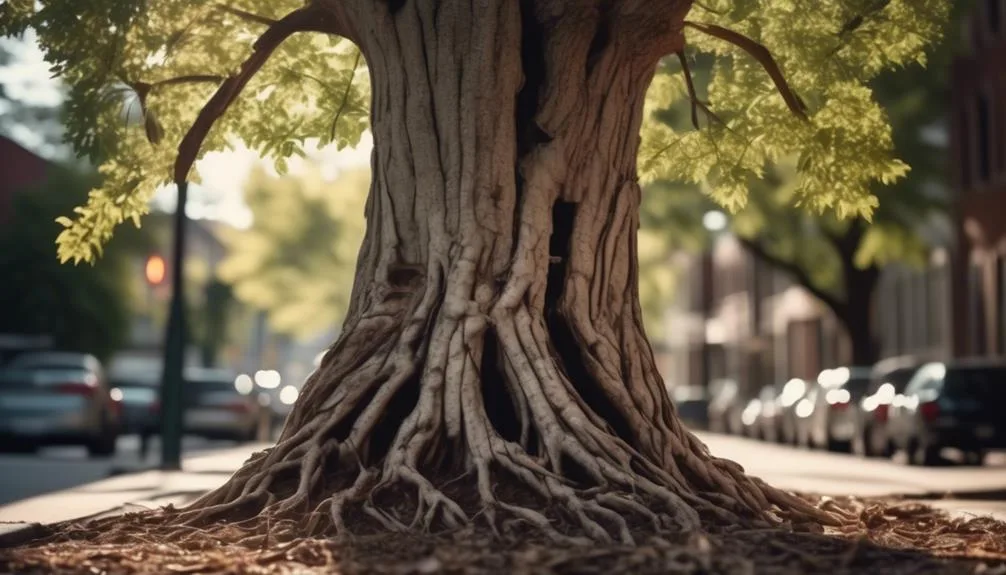Dealing with hickory tree root problems can be a real headache for homeowners. These roots can cause damage to your yard, sidewalks, and underground pipes.
But don't worry, there are ways to tackle these issues. From spotting the signs of hickory tree root problems to safely removing invasive roots, there are strategies to help you regain control of your property.
Whether you're an experienced gardener or a new homeowner, knowing how to handle hickory tree root problems is crucial for a healthy outdoor space.
Identifying Hickory Tree Root Problems
To identify potential hickory tree root problems, carefully inspect the base of the tree for signs of damage or decay. Look for cracks in the soil around the base, which could indicate root damage. Additionally, observe the trunk for any signs of leaning or instability, as this may be a result of root issues. Keep an eye out for fungal growth near the base of the tree, as it could be a sign of decay in the roots.
If you notice any of these signs, it's essential to seek professional help. An arborist can assess the situation and determine the best course of action to address the root problems. Recognizing these signs early and getting expert assistance can help prevent further damage to your hickory tree.
Managing Hickory Tree Root Damage
Inspecting the base of your hickory tree for signs of damage or decay is the first step in managing hickory tree root damage. If you notice any issues, consider implementing the following strategies:
- Root Pruning: Carefully prune damaged or encroaching roots to promote healthy growth and prevent further damage.
- Soil Aeration: Improving soil aeration can help reduce stress on the tree roots and encourage better overall root health.
- Root Barrier Installation: Installing a root barrier can prevent invasive roots from causing damage to nearby structures or pathways.
- Professional Consultation: Seek advice from a certified arborist to evaluate the extent of the damage and determine the best course of action for managing hickory tree root damage.
Taking proactive measures such as managing root pruning and considering root barrier installation can help maintain the health and longevity of your hickory tree.
Preventing Hickory Tree Root Encroachment
When preventing hickory tree root encroachment, it's essential to consider implementing proactive measures to protect surrounding structures and pathways from potential damage.
One effective approach is root barrier installation, creating a physical barrier that directs the roots away from vulnerable areas.
Prioritize soil health by ensuring it's well-drained and aerated, which can help deter roots from seeking moisture in undesirable locations.
Thoughtful landscape design can also play a crucial role in preventing root encroachment. By strategically placing hardscapes and structures, you can limit the space available for root expansion.
Additionally, regular hickory tree maintenance, including strategic pruning and watering, can help manage root growth.
Treating Hickory Tree Root Diseases
Considering the importance of maintaining the health of hickory trees and preventing root encroachment, addressing any potential root diseases promptly is crucial for ensuring the longevity and vitality of these majestic trees. When it comes to treating root diseases in hickory trees, there are several important steps to consider:
- Identify the Symptoms: Look for signs of root rot such as wilting leaves, discolored or decaying roots, and stunted growth.
- Improve Drainage: Ensure proper water drainage to prevent waterlogged soil, which can contribute to root diseases.
- Prune Affected Roots: Trim and remove any infected or damaged roots to prevent the spread of the disease.
- Apply Fungicides: In severe cases of root rot, consider using fungicides to treat the disease and protect the tree's roots.
Removing Hickory Tree Roots Safely
To safely remove hickory tree roots, it's essential to assess the extent of the root system and plan the extraction method accordingly. Start by digging around the base of the tree to expose the roots.
Use a sharp pruning saw or loppers to cut smaller roots, but for larger ones, a reciprocating saw might be necessary. As you cut, ensure to leave enough support for the tree to remain stable.
Once the roots are severed, carefully excavate them from the soil. Proper disposal is crucial to prevent regrowth, so consider composting smaller roots and branches or arranging for professional disposal of larger sections.
Conclusion
Successfully managing hickory tree root issues requires careful identification, proactive management, and safe removal practices.
By addressing these challenges, you can safeguard both your trees' well-being and your property from potential damage.
Consider how these steps can help maintain the health and longevity of your hickory trees while protecting your surroundings.
Mark Hoffman is a dedicated arborist and tree care specialist with over a decade of experience. His love for trees began when he visited Yosemite National Park as a teenager and was awestruck by the giant sequoias. Mark pursued his passion by studying forestry at Michigan Technological University, where he earned a Bachelor of Science degree.
Since then, he has worked tirelessly in the field of arboriculture, helping to preserve and protect trees in his community. His expertise and dedication have made him a respected leader in the industry and a valuable resource for anyone seeking advice on tree care.
